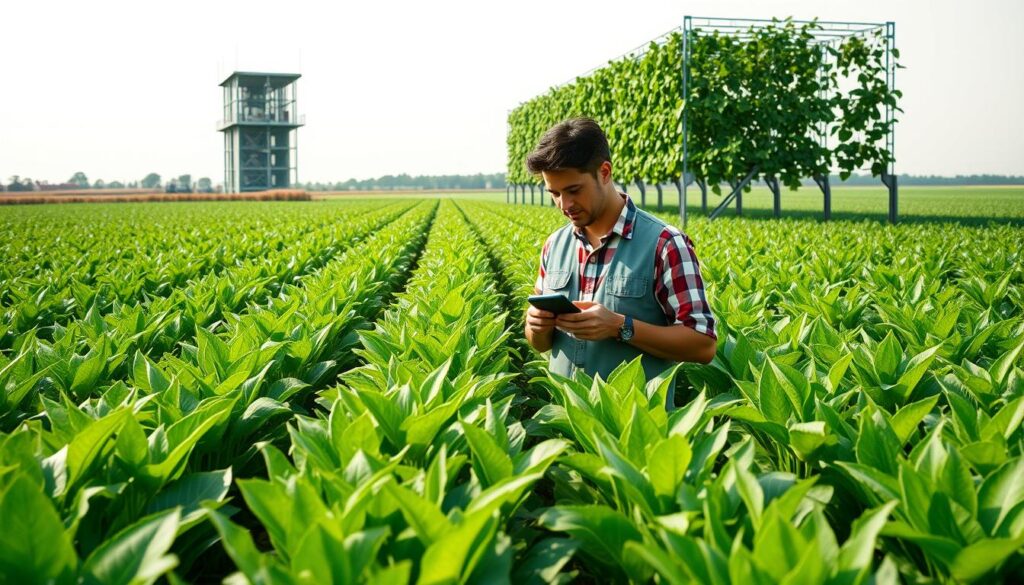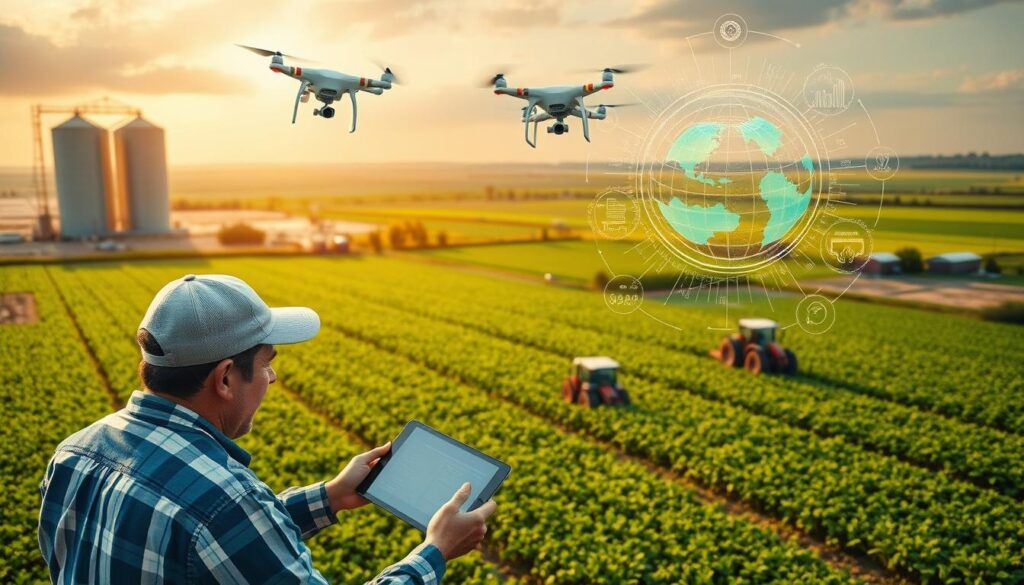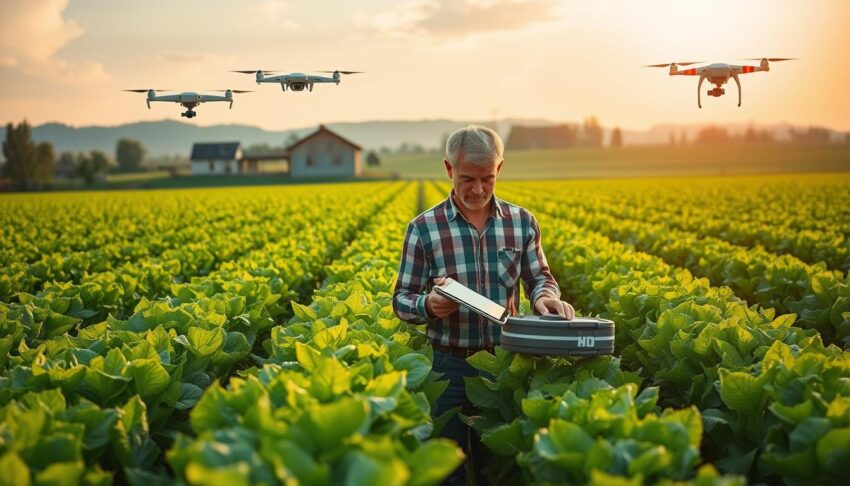What if the secret to a green future in farming is in AI? The farming world faces big challenges like climate change and more food needs. But, AI in farming is not just a dream—it's a must.
AI is making farming better and kinder to our planet. This article shows how AI is changing farming. It's making farming more efficient and helping farmers and us have a better future.
Key Takeaways
- The integration of AI in agriculture is crucial for sustainable farming practices.
- Artificial intelligence tools are helping farmers enhance productivity and efficiency.
- AI is transforming traditional farming methods into data-driven solutions.
- Climate change and food demand pose significant challenges that AI can help address.
- Innovations in agricultural AI are paving the way for a more resilient agricultural sector.
The Rise of AI in Agriculture
The farming world is changing fast. AI is playing a big role in this change. It makes farming better, more efficient, and kinder to the planet.
AI helps farmers grow more food. It also helps them use resources wisely. This tackles the big challenges of modern farming.
Understanding the Importance of AI
AI is very important for farming. It helps farmers make smart choices based on lots of data. This includes using machines to learn and predict things.
AI helps farmers deal with big issues like climate change. It also helps them use resources better. This makes farming more efficient and sustainable.
Current Trends in Agricultural Technology
New tech is changing farming fast. Some big changes include:
- AI-driven analytics for crop management and yield predictions.
- Satellite imagery enhancing land monitoring and assessment.
- IoT integration facilitating real-time data collection and analysis.
These changes are making farming better. They help farmers grow more food and take care of the planet. Using these techs is key to sustainable farming.
| Technology | Description | Benefits |
|---|---|---|
| AI-driven Analytics | Utilizes data to predict crop yields and optimize farming practices. | Higher efficiency and improved decision-making. |
| Satellite Imagery | Provides detailed visuals of crop health and soil conditions. | Enhanced monitoring and timely interventions. |
| IoT Integration | Connects various devices for comprehensive data collection. | Real-time insights for better resource management. |
How Artificial Intelligence is Transforming Farming Techniques
AI is changing farming in big ways. It helps farmers make better choices and work more efficiently. AI looks at data to give insights for smarter farming.
It's used for watching over crops and fighting pests. These are big changes in how we farm.
Innovative Applications of AI in Crop Monitoring
AI helps farmers watch over their crops closely. It uses sensors and satellites to check soil, moisture, and plant health. This way, farmers can see how their crops are doing right away.
Companies like Climate Corporation use this data to guess how much will be harvested. This helps farmers use what they have better. Many farmers say their crops are better and more.
Impact on Pest and Disease Management
AI is also changing how farmers fight pests and diseases. It uses learning machines to spot problems early. This means farmers can act fast to protect their crops.
IBM Watson shows how AI can help in farming. It uses data and predictions to help farmers avoid big problems. This saves time and money and keeps crops healthy.

| Application | Description | Benefits |
|---|---|---|
| Crop Monitoring | Real-time analysis using sensors and satellite data | Improved yield forecasts and resource optimization |
| Pest Management | Predictive analytics for early infestation detection | Targeted interventions minimize resource waste |
| Data Integration | Combining various data sources for decision-making | Enhanced efficiency and farming outcomes |
AI in Agriculture: Precision Farming at Its Best
Precision farming is a new way to farm. It uses smart technology to help farmers work better. Tools like GPS and sensors help farmers use resources well.
These tools make farming more efficient. Farmers can now manage their fields with great accuracy. This leads to better use of resources.
Introduction to Precision Agriculture Solutions
Farmers use new tech to fight challenges and grow more. They use drones and sensors to get data fast. This helps them know when to use fertilizers and pesticides.
This saves time and money. It makes farming more efficient and helps the environment.
Data-Driven Decision Making
Today, farmers make decisions based on data. This helps them work smarter and faster. They can plan better, water more wisely, and use fertilizers right.
Smart tech in farming boosts productivity. It also cuts down waste and harm to the environment. This makes farming more sustainable.
Benefits of Smart Farming Technology
Smart farming technology is changing agriculture a lot. It helps farmers work better and use resources wisely. This makes farming more productive and green.
Enhancing Efficiency and Yield
Smart farming lets farmers watch crops and soil live. They can adjust things right away. This means more food and less waste of water and fertilizer.
Using sensors and data helps farmers know what their fields need. This makes farming better for the planet.
Reducing Labor Costs with Automation
Automation makes farming less dependent on people. Robots help with planting and picking. This saves money and makes work safer.
It also makes work faster. With less people needed, farming will change a lot in the future.
| Benefit | Description | Impact on Farming |
|---|---|---|
| Enhanced Yield | Improved crop monitoring and management | Increased food production |
| Resource Optimization | Efficient use of inputs like water and fertilizers | Lower environmental impact |
| Labor Savings | Use of robots to perform labor-intensive tasks | Reduced operational costs |
| Data-Driven Decisions | Real-time data analysis for better crop management | Improved profitability and sustainability |
Machine Learning in Agriculture: A Game Changer
Machine learning is changing farming. It uses advanced data to help farmers. They can see how crops do in different weather.
This helps farmers make smart choices. They can grow more and take less risk. Tools track how crops grow and spot problems early.
Predictive Analytics for Crop Management
Predictive analytics looks at past data to guess the future. It's key for farming. Machine learning helps farmers understand soil, weather, and pests.
This way, farmers can fix problems before they start. Tools like AgroStar give farmers the info they need. This helps them grow crops better and keep the land healthy.
Optimizing Resource Use with Machine Learning
Machine learning helps farmers use less and get more. It figures out what crops need. This cuts down on waste.
Tools watch how water, fertilizer, and labor are used. This makes farming more efficient. It's good for the planet and saves money for farmers.

Automated Farming Techniques: The Future is Now
New farming methods are changing how we grow food. Drones help by taking pictures from above, mapping fields, and spraying plants. They help keep crops healthy and use less chemicals.
How Drones and Robots Are Reshaping Agriculture
Drones and robots help farmers a lot. They gather data fast and right. This lets farmers check on crops, soil, and water needs quickly.
Drones spot problems like pests or missing nutrients fast. Robots help plant and harvest better, saving time and money.
Integration with Internet of Things (IoT)
IoT makes farming smarter. It uses sensors to send data about the weather and soil. This helps farmers make better choices.
IoT helps use water, fertilizer, and pest control better. It makes farming more efficient. Farmers can grow more food with less waste.
Digital Agriculture Advancements and Their Impact
Digital technology is changing farming a lot. It uses big data to help farmers make better choices. They can now use data from satellites, sensors, and drones.
This helps them know more about the soil, crops, and weather. It makes farming more precise and connects farmers with people who buy their food.
The Role of Big Data in Farming
Big data is very important for farming. It helps farmers use analytics to predict better yields. They can even guess when pests will come.
This helps them plan better and use less. It makes farming more productive and profitable. It also helps avoid losing crops.
Improving Supply Chain Management with AI
AI is changing how we manage farming supplies. It uses data to help farmers plan better. They can know when to send their products.
This reduces waste and makes sure the right amount is delivered. AI looks at trends and market changes. It helps farmers work more efficiently and make more money.
Challenges in Implementing AI in Agriculture
Using artificial intelligence in farming is hard. It's important to solve these problems for farming to get better. Farmers in rural areas face big challenges because of limited internet and high costs.
Technical Limitations and Barriers to Adoption
Internet problems in rural areas hurt AI use. Without internet, farmers can't use AI tools well. This makes farming less productive. The cost of AI is also a big problem, especially for small farms.
Addressing the Skills Gap in Agricultural Tech
There's a big problem with skills in farming. Workers need training for AI. We need to teach farmers how to use AI tools.
Conclusion
AI is changing farming in big ways. It's making farming more precise and efficient. Farmers use new tools to work smarter, not harder.
But, there are still challenges. Like figuring out how to use these new tools better. And making sure everyone knows how to use them.
By learning more and getting better at using technology, farming can get even better. This will help feed more people and protect our planet.
